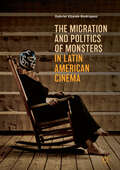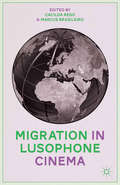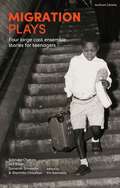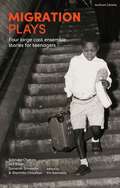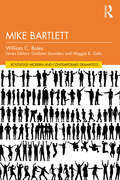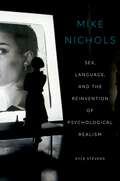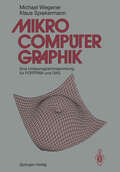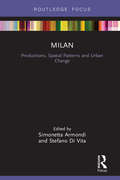- Table View
- List View
Migration and Performance in Contemporary Ireland: Towards a New Interculturalism (Contemporary Performance InterActions)
by Charlotte McIvorThis book investigates Ireland’s translation of interculturalism as social policy into aesthetic practice and situates the wider implications of this ‘new interculturalism’ for theatre and performance studies at large.Offering the first full-length, post-1990s study of the effect of large-scale immigration and interculturalism as social policy on Irish theatre and performance, McIvor argues that inward-migration changes most of what can be assumed about Irish theatre and performance and its relationship to national identity. By using case studies that include theatre, dance, photography, and activist actions, this book works through major debates over aesthetic interculturalism in theatre and performance studies post-1970s and analyses Irish social interculturalism in a contemporary European social and cultural policy context. Drawing together the work of professional and community practitioners who frequently identify as both artists and activists, Migration and Performance in Contemporary Ireland proposes a new paradigm for the study of Irish theatre and performance while contributing to the wider investigation of migration and performance.
The Migration and Politics of Monsters in Latin American Cinema
by Gabriel Eljaiek-RodríguezThe Migration and Politics of Monsters in Latin America proposes a cinematic cartography of contemporary Latin American horror films that take up the idea of the American continent as a space of radical otherness, or monstrosity, and use it for political purposes. The book explores how Latin American film directors migrate foreign horror tropes to create cinematographic horror hybrids that reclaim and transform monstrosity as a form of historical rewriting. By emphasizing the specificities of the Latin American experience, this book contributes to broad scholarship on horror cinema, at the same time connecting the horror tradition with contemporary discussions on violence, migration, fear of immigrants, and the rewriting of colonial discourses.
Migration and Stereotypes in Performance and Culture (Contemporary Performance InterActions)
by Yana Meerzon David Dean Daniel McNeilThis book is an interdisciplinary collection of essays that delves beneath the media headlines about the “migration crisis”, Brexit, Trump and similar events and spectacles that have been linked to the intensification and proliferation of stereotypes about migrants since 2015. Topics include the representations of migration and stereotypes in citizenship ceremonies and culinary traditions, law and literature, and public history and performance. Bringing together academics in the arts, humanities and social sciences, as well as artists and theatre practitioners, the collection equips readers with new methodologies, keywords and collaborative research tools to support critical inquiry and public-facing research in fields such as Theatre and Performance Studies, Cultural and Migration Studies, and Applied Theatre and History.
Migration, Dislocation and Movement on Screen
by Ruxandra TrandafoiuContemporary screen industries such as film and television have become primary sites for visualizing borders, migration, maps, and travel as processes of separation and dislocation, but also connection. Migration, Dislocation and Movement on Screen pulls case studies in film and television industries from throughout Europe, North Africa, and Asia to interrogate the nature of movement via moving images. By combining theoretical, interdisciplinary engagements with empirical research, this volume offers a new way to look at screen media's representations of our contemporary world's transnational and cosmopolitan imaginaries.
Migration, Dislocation and Movement on Screen
by Ruxandra TrandafoiuContemporary screen industries such as film and television have become primary sites for visualizing borders, migration, maps, and travel as processes of separation and dislocation, but also connection. Migration, Dislocation and Movement on Screen pulls case studies in film and television industries from throughout Europe, North Africa, and Asia to interrogate the nature of movement via moving images. By combining theoretical, interdisciplinary engagements with empirical research, this volume offers a new way to look at screen media's representations of our contemporary world's transnational and cosmopolitan imaginaries.
Migration, Dislocation and Movement on Screen
by Ruxandra TrandafoiuContemporary screen industries such as film and television have become primary sites for visualizing borders, migration, maps, and travel as processes of separation and dislocation, but also connection. Migration, Dislocation and Movement on Screen pulls case studies in film and television industries from throughout Europe, North Africa, and Asia to interrogate the nature of movement via moving images. By combining theoretical, interdisciplinary engagements with empirical research, this volume offers a new way to look at screen media's representations of our contemporary world's transnational and cosmopolitan imaginaries.
Migration in Lusophone Cinema
by Cacilda Rêgo Marcus BrasileiroWith more than 250 million speakers globally, the Lusophone world has a rich history of filmmaking. This edited volume explores the representation of the migratory experience in contemporary cinema from Portuguese-speaking countries, exploring how Lusophone films, filmmakers, producers, studios, and governments relay narratives of migration.
Migration in the Southern Balkans: From Ottoman Territory to Globalized Nation States (IMISCOE Research Series)
by Hans Vermeulen Martin Baldwin-Edwards Riki Van BoeschotenThis open access book collects ten essays that look at intra-regional migration in the Southern Balkans from the late Ottoman period to the present. It examines forced as well as voluntary migrations and places these movements within their historical context, including ethnic cleansing, population exchanges, and demographic engineering in the service of nation-building as well as more recent labor migration due to globalization.Inside, readers will find the work of international experts that cuts across national and disciplinary lines. This cross-cultural, comparative approach fully captures the complexity of this highly fractured, yet interconnected, region.Coverage explores the role of population exchanges in the process of nation-building and irredentist policies in interwar Bulgaria, the story of Thracian refugees and their organizations in Bulgaria, the changing waves of migration from the Balkans to Turkey, Albanian immigrants in Greece, and the diminished importance of ethnic migration after the 1990s. In addition, the collection looks at such under-researched aspects of migration as memory, gender, and religion.The field of migration studies in the Southern Balkans is still fragmented along national and disciplinary lines. Moreover, the study of forced and voluntary migrations is often separate with few interconnections. The essays collected in this book bring these different traditions together. This complete portrait will help readers gain deep insight and better understanding into the diverse migration flows and intercultural exchanges that have occurred in the Southern Balkans in the last two centuries.
Migration into art: Transcultural identities and art-making in a globalised world (Rethinking Art's Histories)
by Anne Ring PetersenThis book addresses a topic of increasing importance to artists, art historians and scholars of cultural studies, migration studies and international relations: migration as a profoundly transforming force that has remodelled artistic and art institutional practices across the world. It explores contemporary art’s critical engagement with migration and globalisation as a key source for improving our understanding of how these processes transform identities, cultures, institutions and geopolitics. The author explores three interwoven issues of enduring interest: identity and belonging, institutional visibility and recognition of migrant artists, and the interrelations between aesthetics and politics, including the balancing of aesthetics, politics and ethics in representations of forced migration.
Migration into art: Transcultural identities and art-making in a globalised world (Rethinking Art's Histories)
by Anne Ring PetersenThis book addresses a topic of increasing importance to artists, art historians and scholars of cultural studies, migration studies and international relations: migration as a profoundly transforming force that has remodelled artistic and art institutional practices across the world. It explores contemporary art’s critical engagement with migration and globalisation as a key source for improving our understanding of how these processes transform identities, cultures, institutions and geopolitics. The author explores three interwoven issues of enduring interest: identity and belonging, institutional visibility and recognition of migrant artists, and the interrelations between aesthetics and politics, including the balancing of aesthetics, politics and ethics in representations of forced migration.
Migration Plays: Four large cast ensemble stories for teenagers
by Satinder Chohan Asif Khan Sumerah Srivastav Sharmila ChauhanFeaturing four new plays written and devised in collaboration with groups of secondary school children, this collection examines immigration to and emigration from the UK. A theatre-in-education project coordinated by Tamasha theatre company and The Migration Museum, children worked on exercises designed to develop their understanding of, and feelings about, migration. Their reactions were then incorporated into a piece of theatre by a professional playwright that the students then performed. This collection brings together these plays along with the unique exercises that inspired them. The plays include: Nothing to Declare by Sharmila Chauhan follows three precious keepsakes and the stories attached to them as their owners are stopped at a hostile border. Potato Moon by Satinder Chohan focuses on the potatoes buried in a share allotment. They become people's memories in a magical realist Southall and so when they start to go missing, schoolgirl Mira set out to find out why. Wilkommen by Asif Khan follows 11 year Ammar on the most dangerous journey of his life, from war-torn country, across sea and land, to take up the offer of a new life in Europe. Jigsaw by Sumerah Srivstav tells the story of how three angels, horrified by mankind's cruelty, prepare to wipe them out… until they find an unlikely friend who changes their mind. This is an invaluable collection that gives both teachers the resources to address the sometimes tricky issues surrounding migration and students the opportunity to create and in doing so counteract and humanize the narratives hear in the media and society as a whole.
Migration Plays: Four large cast ensemble stories for teenagers
by Satinder Chohan Asif Khan Sumerah Srivastav Sharmila ChauhanFeaturing four new plays written and devised in collaboration with groups of secondary school children, this collection examines immigration to and emigration from the UK. A theatre-in-education project coordinated by Tamasha theatre company and The Migration Museum, children worked on exercises designed to develop their understanding of, and feelings about, migration. Their reactions were then incorporated into a piece of theatre by a professional playwright that the students then performed. This collection brings together these plays along with the unique exercises that inspired them. The plays include: Nothing to Declare by Sharmila Chauhan follows three precious keepsakes and the stories attached to them as their owners are stopped at a hostile border. Potato Moon by Satinder Chohan focuses on the potatoes buried in a share allotment. They become people's memories in a magical realist Southall and so when they start to go missing, schoolgirl Mira set out to find out why. Wilkommen by Asif Khan follows 11 year Ammar on the most dangerous journey of his life, from war-torn country, across sea and land, to take up the offer of a new life in Europe. Jigsaw by Sumerah Srivstav tells the story of how three angels, horrified by mankind's cruelty, prepare to wipe them out… until they find an unlikely friend who changes their mind. This is an invaluable collection that gives both teachers the resources to address the sometimes tricky issues surrounding migration and students the opportunity to create and in doing so counteract and humanize the narratives hear in the media and society as a whole.
Migrations, Arts and Postcoloniality in the Mediterranean (Routledge Focus on Art History and Visual Studies)
by Celeste IannicielloThis book is focused on the transcultural memory of the Mediterranean region and the different ways it is articulated by contemporary art practices and museum projects linked to migrations, exile, diaspora and transnationality. The artistic and curatorial examples analysed in this study articulate a critical relationship between the cultural representations and the sense of heritage, property and belonging, offering the opportunity of a more problematic and stimulating vision of the preservation of the European arts, traditions and histories. Artists and projects examined include the project Porto M in Lampedusa, Zineb Sedira, Ursula Biemann, Lara Baladi, Mona Hatoum, Emily Jacir, Kader Attia and Walid Raad.
Migrations, Arts and Postcoloniality in the Mediterranean (Routledge Focus on Art History and Visual Studies)
by Celeste IannicielloThis book is focused on the transcultural memory of the Mediterranean region and the different ways it is articulated by contemporary art practices and museum projects linked to migrations, exile, diaspora and transnationality. The artistic and curatorial examples analysed in this study articulate a critical relationship between the cultural representations and the sense of heritage, property and belonging, offering the opportunity of a more problematic and stimulating vision of the preservation of the European arts, traditions and histories. Artists and projects examined include the project Porto M in Lampedusa, Zineb Sedira, Ursula Biemann, Lara Baladi, Mona Hatoum, Emily Jacir, Kader Attia and Walid Raad.
Mike Bartlett (Routledge Modern and Contemporary Dramatists)
by William C. BolesHailed as one of the most talented playwrights to have emerged in the late 2000s, Mike Bartlett's diverse range of plays strike at the heart of the various crises predominant in the early twenty-first century. Offering the first extensive examination of the plays and television series written by award winning playwright Mike Bartlett, this volume not only provides analysis of some of Bartlett’s best-known works (Cock, Doctor Foster, King Charles III, and Albion), but also includes new interviews with Bartlett and some of his closest and oft relied upon collaborators. In this book, Bartlett’s plays and television series are grouped together thematically, allowing the reader to observe the cross-pollination between his works on the stage and screen. The book also includes an introductory biographical chapter that discusses early influences on his writing (Harold Pinter, Mark Ravenhill, Tony Kushner, and Quentin Tarantino), his time in the Young Writers Programme at the Royal Court, and his work with the Apathists.Routledge Modern and Contemporary Dramatists is a series of innovative and exciting critical introductions to the work of internationally pioneering playwrights, giving undergraduate students an ideal point of entry into these key figures in modern drama.
Mike Bartlett (Routledge Modern and Contemporary Dramatists)
by William C. BolesHailed as one of the most talented playwrights to have emerged in the late 2000s, Mike Bartlett's diverse range of plays strike at the heart of the various crises predominant in the early twenty-first century. Offering the first extensive examination of the plays and television series written by award winning playwright Mike Bartlett, this volume not only provides analysis of some of Bartlett’s best-known works (Cock, Doctor Foster, King Charles III, and Albion), but also includes new interviews with Bartlett and some of his closest and oft relied upon collaborators. In this book, Bartlett’s plays and television series are grouped together thematically, allowing the reader to observe the cross-pollination between his works on the stage and screen. The book also includes an introductory biographical chapter that discusses early influences on his writing (Harold Pinter, Mark Ravenhill, Tony Kushner, and Quentin Tarantino), his time in the Young Writers Programme at the Royal Court, and his work with the Apathists.Routledge Modern and Contemporary Dramatists is a series of innovative and exciting critical introductions to the work of internationally pioneering playwrights, giving undergraduate students an ideal point of entry into these key figures in modern drama.
Mike Leigh (British Film-Makers)
by Tony WhiteheadMike Leigh may well be Britain’s greatest living film director; his worldview has permeated our national consciousness. This book gives detailed readings of the nine feature films he has made for the cinema, as well as an overview of his work for television. Written with the co-operation of Leigh himself, this is the first study of his work to challenge the critical privileging of realism in histories of the British cinema, placing the emphasis instead on the importance of comedy and humour: of jokes and their functions, of laughter as a survival mechanism, and of characterisations and situations that disrupt our preconceptions of ‘realism’. Striving for the all-important quality of truth in everything he does, Leigh has consistently shown how ordinary lives are too complex to fit snugly into the conventions of narrative art. From the bittersweet observation of Life is Sweet or Secrets and Lies, to the blistering satire of Naked and the manifest compassion of Vera Drake, he has demonstrated a matchless ability to perceive life’s funny side as well as its tragedies.
Mike Leigh (British Film-Makers)
by Tony WhiteheadMike Leigh may well be Britain’s greatest living film director; his worldview has permeated our national consciousness. This book gives detailed readings of the nine feature films he has made for the cinema, as well as an overview of his work for television. Written with the co-operation of Leigh himself, this is the first study of his work to challenge the critical privileging of realism in histories of the British cinema, placing the emphasis instead on the importance of comedy and humour: of jokes and their functions, of laughter as a survival mechanism, and of characterisations and situations that disrupt our preconceptions of ‘realism’. Striving for the all-important quality of truth in everything he does, Leigh has consistently shown how ordinary lives are too complex to fit snugly into the conventions of narrative art. From the bittersweet observation of Life is Sweet or Secrets and Lies, to the blistering satire of Naked and the manifest compassion of Vera Drake, he has demonstrated a matchless ability to perceive life’s funny side as well as its tragedies.
Mike Nichols: Sex, Language, and the Reinvention of Psychological Realism
by Kyle StevensWith iconic movies like Who's Afraid of Virginia Woolf?, The Graduate, and Carnal Knowledge, Mike Nichols was the most prominent American director during the cultural upheavals of the 1960s. Mike Nichols: Sex, Language, and the Reinvention of Psychological Realism argues that he overhauled the style of psychological realism, and, in doing so, continues to shape the legacies of Hollywood cinema. It also reveals that misreadings of his films were central to foundational debates at the emergence of Cinema Studies as a discipline, inviting new reflections on critical dogma. Focusing on Nichols' classic movies, as well as later films such as Silkwood, The Birdcage, and Angels in America, Kyle Stevens demonstrates that Nichols' realism lies not in the plausibility of his characters but in their inherent mystery. By attending to the puzzling words and silences, breaths and laughter, that comprise these characters, Stevens uncovers new insights into the subversive potential of a range of cinematic elements, and reveals how Nichols' satirical oeuvre, and Hollywood itself, participated in several of the nation's most urgent social, political, and philosophical advances.
MIKE NICHOLS C: Sex, Language, and the Reinvention of Psychological Realism
by Kyle StevensWith iconic movies like Who's Afraid of Virginia Woolf?, The Graduate, and Carnal Knowledge, Mike Nichols was the most prominent American director during the cultural upheavals of the 1960s. Mike Nichols: Sex, Language, and the Reinvention of Psychological Realism argues that he overhauled the style of psychological realism, and, in doing so, continues to shape the legacies of Hollywood cinema. It also reveals that misreadings of his films were central to foundational debates at the emergence of Cinema Studies as a discipline, inviting new reflections on critical dogma. Focusing on Nichols' classic movies, as well as later films such as Silkwood, The Birdcage, and Angels in America, Kyle Stevens demonstrates that Nichols' realism lies not in the plausibility of his characters but in their inherent mystery. By attending to the puzzling words and silences, breaths and laughter, that comprise these characters, Stevens uncovers new insights into the subversive potential of a range of cinematic elements, and reveals how Nichols' satirical oeuvre, and Hollywood itself, participated in several of the nation's most urgent social, political, and philosophical advances.
Mikro-Utopien der Architektur: Das utopische Moment architektonischer Minimaltechniken (ArchitekturDenken #12)
by Sandra MeireisNachdem die Utopie mit dem Eintritt in die »Postmoderne« ab 1968 allmählich in Verruf geriet, zeigt sich in den gegenwärtigen kulturellen Diskursen ihre Rückkehr. Der Tief- und Wendepunkt dieser Entwicklung wird vom Zusammenbruch der kommunistischen Regime 1989/91 markiert. Sandra Meireis stellt für das architektonische Feld die zentrale Hypothese auf, dass sich eine Wiederkehr der Utopie in Form pluraler Mikro-Utopien beobachten lässt. Darüber hinaus zeigt sie auf, dass die Utopie als geschichtsphilosophisches Modell gesellschaftlichen Wandlungen unterliegt und mithin die spätmoderne Tendenz der kulturellen Partikularität reflektiert.
Mikrobielles Leben auf Fassaden
by Wolfgang Hofbauer Georg GärtnerArchitekten, Bauingenieure, Bausachverständige und andere Fachleute sowie Bauherren, Wissenschaftler und Masterstudenten finden in diesem Buch alle Informationen zu Fassadenalgen und -pilzen. Es gibt einen detaillierten Überblick über die Mikroorganismen, die das anfängliche Wachstum an den Außenfassaden von Gebäuden bilden und befasst sich mit den ökophysiologischen Eigenschaften, die die Rahmenbedingungen charakterisieren, unter denen diese Mikroorganismen an Fassaden auftreten können. Neben einem Bestimmungsschlüssel für die charakteristischen Anflüge an Fassaden von Mikroorganismen enthält dieses Buch eine ausführliche Beschreibung der einzelnen Organismen unter Angabe ihres ökologischen Verbreitungsgebiets. Darüber hinaus werden die verschiedenen ökologischen Parameter in kurzen Kapiteln diskutiert. Auch Maßnahmen zur Vorbeugung und Bekämpfung der Besiedelung von Fassaden mit Mikroorganismen werden thematisiert.
Mikrocomputer-graphik: Eine Unterprogrammsammlung für FORTRAN und GKS
by Michael Wegener Klaus SpiekermannIn diesem Buch wird eine Sammlung von Unterprogrammen zur Erzeugung von Graphiken für wissenschaftlich-technische Aufgaben auf einem Mikrocomputer mit Hilfe der Programmiersprache FORTRAN und des Graphikstandards Graphical Kernel System (GKS) vorgestellt. Hauptziel bei der Entwicklung der Unterprogrammsammlung war es, mit einfacher Hardware und geringem Programmieraufwand detailreiche Graphiken für wissenschaftlich-technische Zwecke herstellen zu können. Zur Benutzung der Unterprogrammsammlung genügt deshalb ein Mikrocomputer vom Typ IBM-XT/AT mit HERCULES-Monochrom-Graphikkarte und einem Matrixdrucker mit neun Drucknadeln. Alle Unterprogramme werden im Quellformat aufgelistet und ausführlich erläutert sowie in Demonstrationsprogrammen vorgeführt. Hierdurch kann der Leser ihre Arbeitsweise nachvollziehen und erhält einen Einblick in die Technik der Graphikprogrammierung. Die Darstellung wird durch eine weitgespannte Palette von Anwendungsbeispielen abgerundet.
Milan: Productions, Spatial Patterns and Urban Change (Built Environment City Studies)
by Simonetta Armondi Stefano Di VitaAs a main urban centre of one of the most dynamic European regions, Milan is a key location from which to study narratives of innovations and contemporary productions – old and new manufacturing, tertiary and consumptive sectors, creative and cultural economy – and investigate their influence both on spatial patterns and urban policy agenda. Accordingly, this book explores the contentious geographies of innovation, productions and working spaces, both empirically and theoretically in a city that, since the beginning of the 2000s, has been involved in a process of urban change, with relevant spatial and socio-economic effects, within an increasingly turbulent world economy. Through this analysis, the book provides an insight into the complexity of contemporary urban phenomena beyond a traditional metropolitan lens, highlighting issues such as rescaling, urban decentralization and recentralization, extensive urban transformation and shrinkage and molecular urban regeneration. This book is a valuable resource for academics, researchers and scholars focusing on Urban Studies such as Urban Policy, Urban Planning, Urban Geography, Urban Economy and Urban Sociology.
Milan: Productions, Spatial Patterns and Urban Change (Built Environment City Studies)
by Simonetta Armondi Stefano Di VitaAs a main urban centre of one of the most dynamic European regions, Milan is a key location from which to study narratives of innovations and contemporary productions – old and new manufacturing, tertiary and consumptive sectors, creative and cultural economy – and investigate their influence both on spatial patterns and urban policy agenda. Accordingly, this book explores the contentious geographies of innovation, productions and working spaces, both empirically and theoretically in a city that, since the beginning of the 2000s, has been involved in a process of urban change, with relevant spatial and socio-economic effects, within an increasingly turbulent world economy. Through this analysis, the book provides an insight into the complexity of contemporary urban phenomena beyond a traditional metropolitan lens, highlighting issues such as rescaling, urban decentralization and recentralization, extensive urban transformation and shrinkage and molecular urban regeneration. This book is a valuable resource for academics, researchers and scholars focusing on Urban Studies such as Urban Policy, Urban Planning, Urban Geography, Urban Economy and Urban Sociology.

